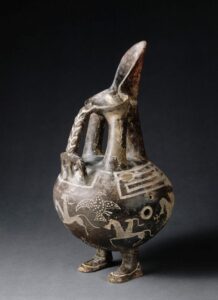The Etruscans, known for their vibrant and innovative culture, contributed significantly to the early art of the Italian peninsula. Among their fascinating artifacts, the anthropomorphic oinochoe, a wine jug shaped in human-like form, offers a remarkable window into their aesthetic values, craftsmanship, and cultural significance. This essay delves into the historical context, artistic features, and symbolic implications of this unique vessel, dated between 710 and 670 BC, likely from Falerii Veteres (modern Civita Castellana) or southern Etruria in Italy.
Historical Context of the Anthropomorphic Oinochoe
The Etruscan civilization flourished in central Italy from around the 8th century BC, a time when Mediterranean cultures were heavily interacting through trade, warfare, and migration. Positioned between the emerging Roman and Greek civilizations, the Etruscans had access to both Eastern Mediterranean influences and indigenous Italic traditions. Artifacts like the anthropomorphic oinochoe reflect this unique confluence of influences. Made between 710 and 670 BC, this jug represents early Etruscan art and their interest in combining utilitarian objects with symbolic and aesthetic values.

Artistic Features and Craftsmanship of the Oinochoe
The anthropomorphic oinochoe is a striking example of the Etruscans’ mastery in pottery and terracotta techniques. Oinochoai (plural of oinochoe) were a common vessel type in both Etruscan and Greek cultures, traditionally used for pouring wine, which held social and ceremonial importance. What sets this Etruscan oinochoe apart is its human-like design, where the vessel’s form is molded to resemble a face or figure, with stylized features that may include exaggerated eyes, nose, and mouth.
Symbolism of Anthropomorphism in Etruscan Art
The anthropomorphic design likely served more than decorative purposes. In Etruscan culture, objects depicting human forms were believed to hold spiritual or protective qualities. By shaping a wine jug to resemble a human, Etruscan artists may have imbued the vessel with symbolic or even magical properties. This anthropomorphism could reflect beliefs in the presence of spirits in objects, a notion that aligns with Etruscan religious and funerary practices.
Function and Use in Etruscan Society
Wine played a central role in Etruscan social and ritual life. The oinochoe would have been used in banquets or funerary ceremonies, where wine was poured as an offering or toasts were made in honor of ancestors and deities. The anthropomorphic jug may have had a particular role in such settings, as it may have served as a special vessel for offerings or held a place in Etruscan tombs, accompanying the deceased in their journey to the afterlife. Artifacts with human features were often included in Etruscan burials, indicating their role in the Etruscans’ belief in an afterlife where such items served practical or protective purposes.

Influence from the Eastern Mediterranean
The anthropomorphic oinochoe shows evidence of Eastern Mediterranean influence, likely a result of Etruscan trade connections with the Greeks and Phoenicians. These foreign interactions brought new techniques and aesthetics to Etruria, influencing local art forms. The stylistic exaggerations on the face of the oinochoe may have been inspired by Eastern traditions, where anthropomorphic pottery and statuary were common. This blending of styles is a hallmark of Etruscan art, as they adapted and reinterpreted foreign elements to create uniquely Etruscan expressions.
Legacy of the Etruscan Anthropomorphic Oinochoe
Artifacts like the anthropomorphic oinochoe highlight the Etruscans’ ability to synthesize foreign ideas with their own cultural symbols, creating artworks that are both functional and deeply expressive. This approach to art would later influence Roman culture, which inherited many aspects of Etruscan religious, artistic, and social practices. The Etruscan tradition of infusing everyday objects with spiritual or human characteristics persisted, marking the beginning of an artistic legacy that valued symbolism as much as function. The anthropomorphic oinochoe remains a testament to the Etruscans’ sophisticated view of life, death, and the afterlife, embodied in the crafted shapes that still captivate modern audiences today.
Conclusion
The anthropomorphic oinochoe is a valuable artifact that encapsulates the essence of Etruscan artistry, spiritual beliefs, and cultural interconnectedness with the Mediterranean world. Its human-like form not only reflects the Etruscan fascination with anthropomorphism but also reveals how they perceived and honored life’s various domains—from everyday gatherings to sacred rituals and the mystery of the afterlife. As such, this jug serves as a tangible reminder of the Etruscan legacy, offering insight into their artistic innovation, cultural exchanges, and enduring impact on Western art and culture.
